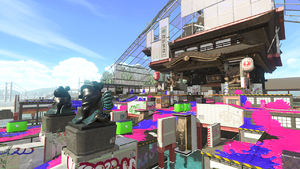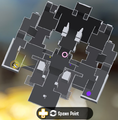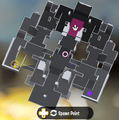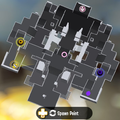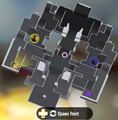Skipper Pavilion
Skipper Pavilion is a stage in Splatoon 2 added in Version 4.1.0.[1] It is set in a Japanese-styled pavilion. Unlike most stages, it features lateral symmetry.
Layout
Unlike most other stages in the Splatoon series that feature rotational symmetry, Skipper Pavilion's stage layout is laterally symmetrical. The spawn point is at the top of the stage, at adjacent corners. Directly in front of the spawn point is a ramp that leads down to a platform which has access to a raised platform with a large statue and gratings. Downwards from the main spawn platform is another platform with a ramp facing away from the center which leads to a raised platform. At the spawn point, on the side furthest from the center, is a walkway that drops off to the previously mentioned raised platform. From the middle platform is another layer, with a ramp leading to a small area and another ramp leading to the main area. The bottom of the center area is large and relatively flat, save for a slightly raised section at the very end. The center has a pathway going up from the far end of the stage, which leads up to the temple, which is large and flat with a pillar in the center.
Design
Skipper Pavilion is an Asian-style pavilion off a coast, housing a temple theater that is under construction. The stage is supported by beams, which raises it above water, though players need to be careful as they are still able to fall and dissolve. The spawn point is surrounded with Shōji, or rice paper walls. The very bottom of the stage has a Kansho garden, with stone paths, small trees and raked gravel. Near the garden are two iron statues of mudskippers with blue accents that parody real-life Komainus. On the edges of the stages are ema boards, which normally have visitors write down wishes and leave the notes on them. On the sides are glass rooms serving as spas and practice ranges, occupied with jellyfish. The spas are decorated with plants and have vending machines, and the practice ranges have mats, targets, and blinds, and is surrounded with shimenawa. The theater houses mats, cushions and display cases, and is supported by pillars covered with tarps. Above is a sign written in Inkling and the platform is surrounded by short wooden guardrails. In the front are two large stone statues, one of an Inkling squid and one of an Octoling octopus, whose bases are covered for construction. Above are two large paper lanterns. All around the stage are construction panels, crates, barriers, grating and tarps which are used as obstacles or platforms the players can use to access more of the stage. The walls in the center are either glass displays and construction tarp, which are uninkable, or wooden boards, which are inkable. In the distance are rock islands with trees, observation boardwalks and a temple surrounded by trees. In the far distance is a city, presumably Inkopolis.
Ranked Battle terrain
In Ranked Battles, specifications for the terrain or placement of objects are different between the modes; these changes create new paths or new objects to take cover behind.
Splat Zones
The zone is located in the rock garden on the far side of the stage furthest from both teams' spawn points. An Inkrail is added in front of spawn to get to the middle area quicker. Several blocks have been added or rearranged in the lower section of the stage, but the overall layout is relatively unchanged.
Tower Control
The layout of the stage is relatively the same. However, a large series of uninkable platforms have been added over the large gaps in the lower area. This area allows access to the upper portions of each team's spawn point. The Tower is located on the far side of the stage, on the wooden pavilion in the lowest area. From that point, the Tower moves beside the lower ramp, up one level. After crossing the area, it ascends straight up to the next level, then the goal is at the far side of that platform.
| In Splatoon 2, checkpoints have been added: | |||||
|---|---|---|---|---|---|
| Checkpoint | Location | Timer (Seconds) | Progress Amount | ||
| Before | After | Total | |||
| 1 | The first checkpoint is located in the very bottom area, near the Tower's starting location. | 6 | 91 | 79 | 12 |
| 2 | The second checkpoint is located on the lip of the platform right above the previous area. | 5 | 57 | 47 | 10 |
| 3 | The third checkpoint is located on the platform above the previous area before the goal. | 4 | 22 | 14 | 8 |
Rainmaker
The Rainmaker is located at the far end the stage, as far away from each team's spawn point as possible, on the wooden stage. The goal is located at the edge of the same level as each team's spawn point. Ramps have been added between each level to facilitate moving upwards. A slightly protruding path has also been added, leading up to the highest level. An entirely new section of uninkable bridges has also been added over the gaps in the lower section of the stage to allow more routes of entry. Routes to the goal are very limited on Skipper Pavilion.
Clam Blitz
In Clam Blitz, the baskets are located on the middle layer of each team's side - two layers below each team's spawn point or two layers up from the lowest part of the stage. The base layout of the stage is similar to that of Rainmaker, featuring ramps between each layer as well as a ramp in the central hallway which allows access to the second-highest level of each team's side. However, unlike Rainmaker, the additional walkways above the open gaps are not present, and neither is the extension to the side of each team's base.
Splatoon 2
| Added in | 4.1.0 |
| Total area | 2,439p |
| Features | Inkrails(SZ) and sponges(TW, SZ, TC) |
| Hazards | Water |
Skipper Pavilion was the final regular stage to be added to Splatoon 2. It was announced on 20 September 2018 and was made available on 3 October 2018 as part of Version 4.1.0.
Version history
| Version | Adjustments |
|---|---|
| 4.2.0 |
|
| 5.4.0 |
|
| 5.5.0 |
|
Maps
-
Turf War
-
Splat Zones
-
Tower Control
-
Rainmaker
-
Clam Blitz
Gallery
-
-
-
-
A wooden replica of the Rainmaker.
-
Wooden replicas of Suction Bombs.
-
Various wooden replicas of chargers.
-
A wooden statue of the Octobrush
-
Skipper Pavilion during a Splatfest.
-
Turf War (Splatfest) icon for Skipper Pavilion.
-
An example of in-universe street art, specifically during a Splatfest.
Quotes
| View the quotation page. |
Trivia
- Skipper Pavilion has lateral symmetry rather than rotational symmetry, similar to Saltspray Rig, Zappy Longshocking, and Bridge to Tentaswitchia.
- In Skipper Pavilion, statues of old Rainmakers, Suction Bombs, and several weapons are displayed in several parts of the stage.
- Skipper Pavilion's name may be a reference to the real-life mudskipper.
- This is supported by the fact that some of the statues resemble mudskippers in both shape and color.
- In the English, Dutch, European French, German, Latin American Spanish and Russian localizations, Marina claims that it is said that splatting someone between the two large iron statues in the middle of the map will bring good luck. In the Japanese, European Spanish and Italian versions, she claims that coming to the building that brings good luck in Turf Wars.
- During a Splatfest, if the player went into Recon mode, it was possible to hear the Chorus of Calamari County in the background.[2]
- The statues found on this stage, can be used as Locker decorations in Splatoon 3.
Names in other languages
| Language | Name | Meaning |
|---|---|---|
| ムツゴ楼 Mutsugo Rō |
Mutsugo Tower[note 1] | |
| Palingpaviljoen | Eel pavilion | |
| Lagune aux gobies | Goby lagoon | |
| Grundel-Pavillon | Goby pavilion | |
| Padiglione Capitone | Eel Pavilion | |
| Парк «Во Сток!» Park «Vo Stok!» |
«Into the Drain!» park[note 2] | |
| Puerta del Gobio | Goby Gate | |
| Mirror | Likely refers to the stage's lateral symmetry. |
